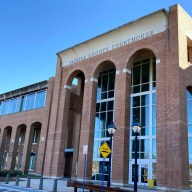WASHINGTON – Bad wiring and a leak in what’s supposed to be a “blowout preventer.” Sealing problems that may have allowed a methane eruption. Even a dead battery, of all things.
New disclosures Wednesday revealed a complex cascade of deep-sea equipment failures and procedural problems in the oil rig explosion and massive spill that is still fouling the waters of the Gulf of Mexico and threatening industries and wildlife near the coast and on shore.
Meanwhile, a new containment box — a cylinder called a “top hat” — was placed on the sea floor near the well leak. Engineers hope to work out ways to avoid the problem that scuttled an earlier effort with a much bigger box before they move the cylinder over the end of the 5,000-foot (1,500-meter)-long pipe from the well.
The public also got its first look on Wednesday of oil gushing from the broken pipe that rests nearly a mile (1.6 kilometre) under water as BP PLC, the well’s operator, released a video taken by a remotely controlled camera. Oil flowing from a break in the yellowish pipe becomes lighter in colour as it mixes with natural gas. Over the past 21 days more than 4 million gallons (15 million litres) of oil have been released.
A litany of worrisome events and findings that were at play on the night of the well explosion and pipe rupture was described in internal corporate documents, marked confidential but provided to a House of Representatives committee by BP and by the manufacturer of the safety device. Lawmakers released them at a House hearing.
A senior BP executive, Lamar McKay, cautioned, “It’s inappropriate to draw any conclusions before all the facts are known.” But the documents established the firmest evidence to date of the sequence of catastrophic events that led to the explosion and worsening spill, a series of failures more reminiscent of the loss of the space shuttle Challenger than the wreck of the Exxon Valdez.
Like the 1986 Challenger disaster, the investigation into the Gulf spill may well show that complex and seemingly failproof technical systems went wrong because of overlooked problems that interacted with each other in unexpected ways. In the 1989 Exxon Valdez disaster, a captain simply ran his ship onto a reef in Alaska’s Prince William Sound, spilling nearly 11 million gallons (41.6 million litres) of oil.
The April 20 BP rig explosion 40 miles (64 kilometres) off the Louisiana coast killed 11 people. Oil continuing to flow into Gulf waters threatens sensitive ecological marshes and wetlands and the region’s fishing industry.
Congressional investigators revealed Wednesday that a key safety system, known as the blowout preventer, used in BP’s oil-drilling rig in the Gulf had a hydraulic leak and a failed battery that probably prevented it from working as designed.
They said that BP documents and others also indicated conflicting pipe pressure tests should have warned those on the rig that poor pipe integrity may have been allowing explosive methane gas to leak into the well.
Asked about the tests, Steven Newman, president of Transocean, which owned the drilling rig, and Lamar McKay, president of BP America told the committee the pressure readings were worrisome.
They indicated “that there was something happening in the well bore that shouldn’t be happening,” said Newman. McKay said the issue “is critical in the investigation” into the cause of the accident.
The well explosion unleashed a massive oil spill that after three weeks remains uncontained.
But Democratic Rep. Henry Waxman said important elements of what went wrong were beginning to surface.
While “we have far more questions than answers,” he said it appears clear that there were problems with the blowout preventers before the accident and confusion almost right up to the time of the explosion over the success of a process in which cement is injected into the well to temporarily close it in anticipation of future production.
The House Energy and Commerce Committee hearing into the spill was the third this week at which executives of BP and two other companies were questioned by lawmakers.
The committee produced one document from BP that provided the most detailed information to date on what led up to and may have caused the explosion and spill at the Deepwater Horizon rig, floating in mile-deep waters 40 miles (65 kilometres) off the coast of Louisiana, and why equipment designed to stop a spill failed to do the job.
Democratic Rep. Bart Stupak said there were at least “four significant problems with the blowout preventer” — or BOP — including evidence that it had a significant hydraulic leak and a dead battery that was supposed to activate a so-called “deadman” trigger.
In Kenner, Louisiana, where a separate hearing is being held as part of a U.S. Coast Guard and Interior Department investigation, Michael Saucier of the Minerals Management Service testified the government isn’t required to inspect the BOPs as they are built and when installed. Operators are required to test the devices every two weeks, and Saucier said the MMS monitors those tests. He said the agency relies on drillers to ensure the device is working properly.
A 2001 report by Transocean, which bought the BOP from Cameron, indicated there can be as many as 260 failure possibilities in the equipment, which is supposed to be the final safeguard against a well blowout by clamping down and sealing a gushing oil well, said Stupak, chairman of the panel’s investigation’s subcommittee.
“How can a device that has 260 failure modes be considered fail-safe?” asked Stupak.
Executives of the companies involved have sought to shift blame on one another at Senate and House hearings this week on the spill.
BP has cited the failure of the blowout preventer owned by Transocean, which in turn has raised questions about the cementing process conducted by Halliburton, a BP subcontractor.
















